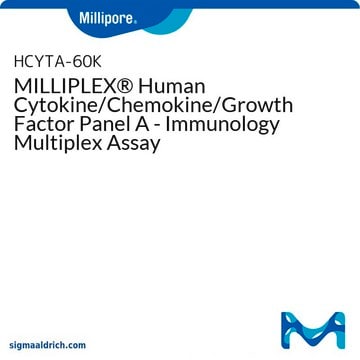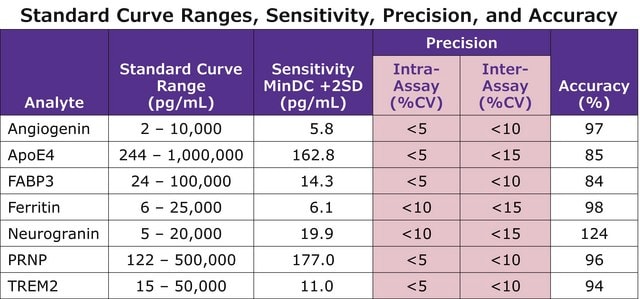Our R&D team conducted spike recovery and dilution linearity tests in rat serum samples. The sequence for both rat and mouse is identical. Although we attempted to develop this kit for both rat and mouse, the recovery in rats was considerably lower compared to mice. As a result, we do not recommend this kit for use with rats. Verification tests were not carried out in cerebrospinal fluid (CSF) or rat brain samples to assess potential improvement in recovery for other sample types.
HNDG4MAG-36K
11468 Human Neurodegenerative Disease Magnetic Bead Panel 4 - Neuroscience Multiplex Assay
The analytes available for this multiplex kit are: Amyloid β40, Amyloid β42, GDNF, sRAGE, S100B.
About This Item
Polecane produkty
Poziom jakości
reaktywność gatunkowa
human
producent / nazwa handlowa
Milliplex®
assay range
accuracy: 84-108%
standard curve range: 14-10,000 pg/mL
(S100B)
standard curve range: 21-15,000 pg/mL
(sRAGE)
standard curve range: 27-20,000 pg/mL
(Amyloid β42)
standard curve range: 3-2,500 pg/mL
(Amyloid β40)
standard curve range: 7-5,000 pg/mL
(GDNF)
metody
multiplexing: suitable
metoda wykrywania
fluorometric (Luminex xMAP)
Warunki transportu
wet ice
Opis ogólny
Typ panelu: Neuroscience
Specyficzność
Reaktywność krzyżowa między przeciwciałami i innymi analitami w tym panelu jest niewykrywalna lub nieistotna.
Zastosowanie
- Anality: Amyloid β40, Amyloid β42, GDNF, sRAGE, S100B
- Zalecany typ próbki: PŁYN MÓZGOWO-RDZENIOWY
- Zalecane rozcieńczenie próbki: 1:3
- Czas działania testu: Przez noc
- Kategoria badawcza: Neuronauka
Cechy i korzyści
Opakowanie
Przechowywanie i stabilność
Inne uwagi
Informacje prawne
Oświadczenie o zrzeczeniu się odpowiedzialności
Hasło ostrzegawcze
Danger
Zwroty wskazujące rodzaj zagrożenia
Zwroty wskazujące środki ostrożności
Klasyfikacja zagrożeń
Acute Tox. 3 Dermal - Acute Tox. 4 Inhalation - Acute Tox. 4 Oral - Aquatic Chronic 2 - Skin Sens. 1
Kod klasy składowania
6.1C - Combustible acute toxic Cat.3 / toxic compounds or compounds which causing chronic effects
Certyfikaty analizy (CoA)
Poszukaj Certyfikaty analizy (CoA), wpisując numer partii/serii produktów. Numery serii i partii można znaleźć na etykiecie produktu po słowach „seria” lub „partia”.
Masz już ten produkt?
Dokumenty związane z niedawno zakupionymi produktami zostały zamieszczone w Bibliotece dokumentów.
Powiązane treści
Learn how multiplex detection of Alzheimer’s disease biomarkers, using the MILLIPLEX® Human Amyloid Beta and Tau Magnetic Bead Panel, allows for a different perspective on neurodegenerative disease research.
Neuroscience multiplex assays, such as MILLIPLEX® multiplex assays, enable simultaneous measurement of neuroscience-related biomarkers to gain a better picture of neurodegenerative diseases, neurological disorders, and neuropeptide/neurohormone signaling.
-
Is the Milliplex Mouse Amyloid Beta Panel (MABMAG-83K) suitable for testing rat samples?
1 answer-
Helpful?
-
-
What is the reason that GLP-1 total and active cannot be run together in HMHEMAG-34K?
1 answer-
The same capture is used for both total and active GLP-1; however, the detection is specific to either total or active GLP-1.
Helpful?
-
Active Filters
Nasz zespół naukowców ma doświadczenie we wszystkich obszarach badań, w tym w naukach przyrodniczych, materiałoznawstwie, syntezie chemicznej, chromatografii, analityce i wielu innych dziedzinach.
Skontaktuj się z zespołem ds. pomocy technicznej










